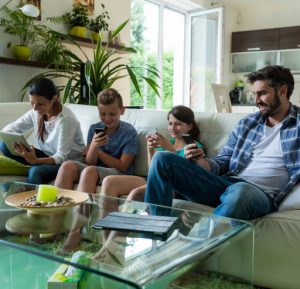Download a printable copy of this article (PDF 491KB)
“We live in a society exquisitely dependent on science and technology, in which hardly anyone knows anything about science and technology.”
– Carl Sagan

A wise parent and care giver understands that it’s not just the strategies you use, it’s not just the words you say, and it’s not just the actions you encourage that put young people on the right path to being safe online.
What’s important for today’s parents and carers to focus on is to build an environment, a home, around your children that is technologically safe and responsible.
This article will outline five things that a contemporary parent can choose to do to make their home just that little bit more technologically safe.
- Block adult content.
It is appropriate that you examine your child’s browser history occasionally to see the types of pages and the types of sites that your child may choose to access. This assists in ensuring they don’t make inappropriate choices or accidental discoveries an online habit. If you are informed you can block these sites and also encourage sites that you wish them to access. - Have the porn talk.
Young people are curious by nature and that curiosity will sometimes lead them into dangerous or inappropriate places. If they arrive at these sites it’s important that they have already been helped to decide on the best actions to take.
As awkward as it is, parents and carers are well placed to partner in those decisions. If children are unprepared when they arrive in the online world where porn is prevalent, then the likelihood is higher that their curiosity will see them explore further. It is important for them to know that the porn industry does not represent what a healthy attitude towards sex and sexuality is all about and that they can get better information from a more reliable source, such as the home. - Public device use.
While the home is a private space, it is a good idea to make the use of devices within the home as public as possible. This means that you reduce access to environments where children can use devices and laptops behind closed doors.Almost all kinds of behaviours are improved where supervision is high, so encourage or insist that your children use their devices at the kitchen bench, in the lounge room, and in places where you can glance over their shoulder. The supervision factor sounds intrusive, but is genuinely supportive in helping young people to make more responsible choices. - Ask for advice FROM them.
One of the most powerful things that a parent and carer can do is acknowledge the expertise that young people have in the online world.The place of the tech advisor in a school could possibly be the job that is the most in peril … because the truth is, in any high school, there are several hundred young people who often know more about technology and more about the online world than the adults employed there! Young people are often experts on the online world, and when you respect that expertise, you encourage them to share their knowledge and also their activity with you. - Consider a cyber safety package.
There are packages available to support you to create an environment where your children can access significantly less of the material that can cause them harm. While acknowledging that these packages are not always affordable to families, they can genuinely assist you to make your home as technologically safe as it can possibly be. It can be a sacrifice to make, but you always need to remember the goal behind this investment.
For further information, websites such as the Office of the eSafety Commissioner and Bullying. No Way! provide a range of helpful materials.


